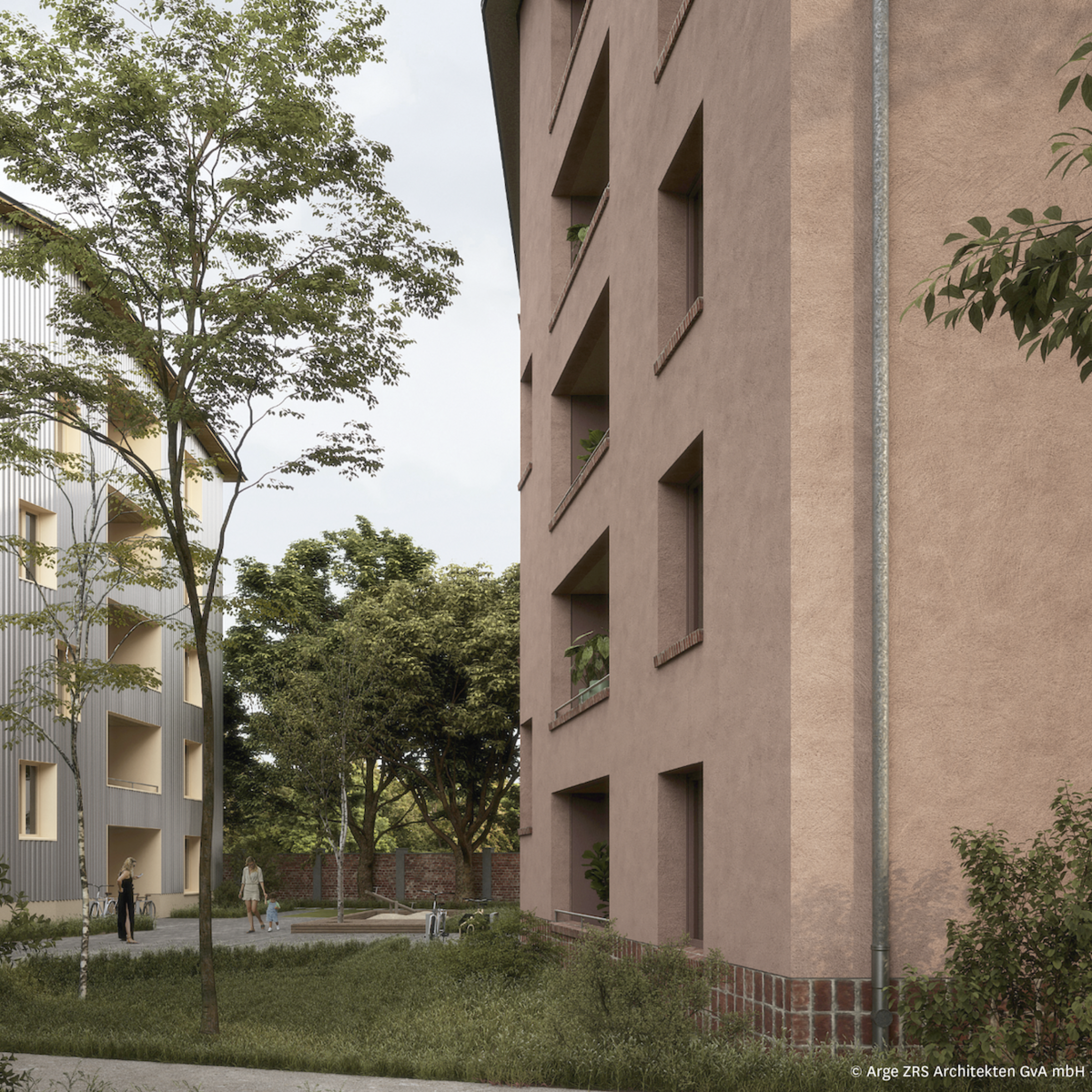Topping-Out Ceremony for Sustainable Housing Construction in Berlin
STADT UND LAND Constructs Two Buildings Using Brick-Clay and Wood-Clay Construction in Alt-Britz, Neukölln, as “Sustainability Pilots”. The buildings aim to explore CO₂ savings, low-tech strategies, and resource-efficient construction. The goal is to develop circular and affordable construction methods for rental housing.
Milestone for Sustainable Construction
On March 5, 2025, STADT UND LAND celebrated the topping-out ceremony for the sustainability pilot project in Alt-Britz 107/107A, 12359 Berlin, in the presence of representatives from politics and science. Among them were Ute Bonde, Senator for Mobility, Transport, Climate Protection, and Environment; Alexander Slotty, State Secretary for Construction and Head of the Senate Department for Urban Development, Building, and Housing; and Martin Hikel, District Mayor of Neukölln.
The two buildings, offering a total of 36 rental apartments—18 of them barrier-free and 6 subsidized—integrate into an existing residential area in Alt-Britz. The five-story buildings have identical layouts and volumes but are constructed using different materials to allow long-term comparisons between the brick-clay and wood-clay construction methods.
Scientific Support and Monitoring
Both buildings will undergo scientific evaluation during the planning and construction phases, as well as in their initial years of operation. The goal is to assess the ecological and economic potential of sustainable building materials, a robust low-tech approach, and optimized layouts for rental housing. The real-world laboratory aims to demonstrate how much CO₂ can be saved using materials like wood, clay, and recycled materials while still meeting thermal, acoustic, and fire protection requirements.
After completion, a monitoring phase will analyze living quality, energy consumption, and environmental impact. The findings will be compared to conventional construction methods to gain valuable insights for multi-story housing. With this project, STADT UND LAND contributes to the development of circular, technology-reduced, and affordable construction methods. It demonstrates how sustainable materials can be integrated into social housing in the long term and how climate-friendly construction with low operating costs can be achieved.
Funding and Implementation
The project is supported by the Berlin Senate Department for Environment, Mobility, Consumer Protection, and Climate Protection, as well as the German Federal Environmental Foundation (DBU). It is being implemented by STADT UND LAND in collaboration with ARGE ZRS Architekten and Bruno Fioretti Marquez, with scientific support from the Technical University of Braunschweig, the Technical University of Berlin, and the University of Stuttgart.
Voices on the Project
Ute Bonde, Senator for Mobility, Transport, Climate Protection, and Environment:
“Berlin needs housing construction that takes a holistic approach to sustainability—considering the entire life cycle of a building. The 'Sustainability Pilots' are perfectly aligned with the goals of the Berlin Energy and Climate Protection Program 2030 and provide forward-looking impulses for climate-neutral new buildings.”
Alexander Slotty, State Secretary for Construction:
“STADT UND LAND’s real-world laboratory demonstrates that state-owned companies are exemplary innovation drivers for Berlin. I am eager to see the results. Our goal is clear: we want affordable, safe, and climate-friendly housing. Every new apartment means a new home for Berliners. This pilot project shows how environmentally and resource-efficient construction can also be cost-effective in the future.”
Martin Hikel, District Mayor of Neukölln:
“Neukölln is not only about diversity but also about innovative approaches and sustainable developments. This pilot project ensures affordable and barrier-free living today while considering the future. I wholeheartedly welcome this addition to the Alt-Britz neighborhood and look forward to welcoming new Neukölln residents soon.”
Natascha Klimek, Managing Director, STADT UND LAND:
“We are building at the limit. Raw material reserves are dwindling, landfill space is becoming scarce, and climate targets remain ambitious. In the construction industry, currently used materials are responsible for over 50% of global greenhouse gas emissions, 52% of waste generation, and 90% of mineral resource consumption. A key approach to reducing these figures lies in targeted construction measures. This project makes a crucial contribution by using natural materials such as wood, brick, and clay in building envelopes, reducing CO₂ emissions by at least 50% compared to conventional construction methods.”
Ingo Malter, Managing Director, STADT UND LAND:
“This pilot project aims to demonstrate that higher initial investments in resource-efficient construction can be offset in the long run by lower operating, maintenance, and deconstruction costs. We hope this project will contribute to the development of circular and technology-reduced construction methods. Through scientific evaluation, we aim to provide solid insights for multi-story housing. Construction must become simpler and faster. Buildings need to be more robust, more durable, and require longer maintenance intervals. Sustainability and economic efficiency do not have to be mutually exclusive.”
Sabine Djahanschah, German Federal Environmental Foundation (DBU):
“Intelligent building technology planning and sustainable materials like wood and clay are ideal for creating a good indoor climate. This creates a win-win situation for both the environment and consumers: resources are conserved as construction elements and materials like wood and clay can be reused or repurposed, while efficient climate technology helps save costs. With DBU-funded model projects like this, we aim to accelerate energy-efficient building and living.”
Prof. Eike Roswag-Klinge, Technical University of Berlin:
“Natural building materials and their climate-regulating properties open up perspectives for cost-effective, climate-friendly, and healthy low-tech housing. Even during the design phase, extensive life cycle assessments identified significant savings potential and lower greenhouse gas emissions compared to conventional construction methods. As soon as the buildings are operational, we will enter a monitoring phase to further validate our hypotheses.”
Prof. Piero Bruno, IWE University of Stuttgart:
“The wood-clay and brick-clay buildings show that not all solutions need to be purely technical. They represent a return to essentials, where the intelligence of the materials and building structures is expressed while embracing the principles of circular economy.”
For further information about the growth industries, economic development, business and technology support for companies, investors and scientific institutions in the Airport Region Berlin Brandenburg please contact:
Sandra Koletzki | sandra.koletzki(at)airport-region.de
(Source: STADT UND LAND Wohnbauten-Gesellschaft mbH, 03|05|2025 | “"Holz Ziegel Lehm" – STADT UND LAND Celebrates Topping-Out Ceremony for the Sustainability Pilot in Alt-Britz”)

